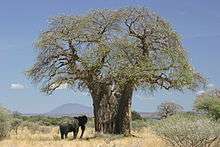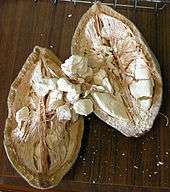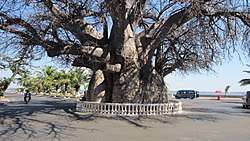Adansonia digitata
| Adansonia digitata | |
|---|---|
 | |
| Baobab tree in Tanzania | |
| Scientific classification | |
| Kingdom: | Plantae |
| (unranked): | Angiosperms |
| (unranked): | Eudicots |
| (unranked): | Rosids |
| Order: | Malvales |
| Family: | Malvaceae |
| Genus: | Adansonia |
| Species: | A. digitata |
| Binomial name | |
| Adansonia digitata L. | |
| Synonyms | |
| |
Adansonia digitata (baobab) is the most widespread of the Adansonia species, and is native to the African continent. The long-lived pachycauls are typically found in dry, hot savannahs of sub-Saharan Africa, where they dominate the landscape, and reveal the presence of a watercourse from afar.[2] Their growth rate is determined by ground water or rainfall,[3][4] and their maximum age, which is subject to much conjecture, seems to be in the order of 1,500 years.[5] They have traditionally been valued as sources of food, water, health remedies or places of shelter and are steeped in legend and superstition.[3] European explorers of old were inclined to carve their names on baobabs, and many are defaced by modern graffiti.[2] Common names for the baobab include dead-rat tree (from the appearance of the fruit), monkey-bread tree (the soft, dry fruit is edible), upside-down tree (the sparse branches resemble roots) and cream of tartar tree (cream of tartar).
Naming and description
The vernacular name "baobab" is derived from Arabic بو حِباب (būħibāb), which means "father of many seeds". The scientific name Adansonia refers to the French explorer and botanist, Michel Adanson (1727–1806), who observed a specimen in 1749 on the island of Sor, Senegal.[6] On the nearby Îles des Madeleines Adanson found another baobab, 3.8 m in diameter, which bore the carvings of passing mariners on its trunk, including those of Henry the Navigator in 1444 and André Thevet in 1555.[2] When Théodore Monod searched the island in the 20th century, the tree was not to be found however. Adanson concluded that the baobab, of all the trees he studied, “is probably the most useful tree in all.” He consumed baobab juice twice a day, while in Africa. He remained convinced that it maintained his health for him.[7] "Digitata" refers to the digits of the hand. The baobab's compound leaves with normally five (but up to seven) leaflets are akin to a hand.[8]
Habit and physical description
_in_Hyderabad_W_IMG_8271.jpg)


The trees usually grow as solitary individuals, and are large and distinctive elements of savannah or scrubland vegetation. Some large individuals live to well over a thousand years of age.[9] All baobab trees are deciduous, losing their leaves in the dry season, and remains leafless for nine months of the year.
They can grow to between 5–25 m (16–82 ft) in height. They are in fact known both for their height and trunk's girth. The trunk tends to be bottle-shaped and can reach a diameter of 10–14 m (33–46 ft).[10] The span of the roots actually exceed the tree's height, a factor that enables it to survive in a dry climate. Many consider the tree to be “upside-down” due to the trunk likeness to a taproot and the branches akin to finer capillary roots. The trunk is smooth and shiny[11] and can range from being reddish brown to grey. The bark can feel cork-like.[7] The branches are thick and wide and very stout compared to the trunk.
During the early summer (October to December in southern hemisphere)[12] the tree bears very large, heavy, white flowers. These are 12 cm (4.7 in) across and open during the late afternoon to stay open for one night.[3][10] The pendulous, showy flowers have a very large number of stamens. They have a sweet scent but later emit a carrion smell, especially when they turn brown and fall after 24 hours.[3][10] Researchers have shown that they appear to be primarily pollinated by fruit bats of the subfamily Pteropodinae. The flowers have 5 petals that are leathery and hairy on the inside. The sepals are cup-shaped and 5-cleft. The stamens are divided into multiple anthers and styles are 7-10 rayed.
The indehiscent fruit are large, egg-shaped capsules.[3] They are filled with pulp that dries, hardens, and falls to pieces which look like chunks of powdery, dry bread.[13] The seed are hard, black and kidney-shaped.[3]
Range
The northern limit of its distribution in Africa is associated with rainfall patterns; only on the Atlantic coast and in the Sudan does its occurrence venture naturally into the Sahel. On the Atlantic coast, this may be due to spreading after cultivation. Its occurrence is very limited in Central Africa, and it is found only in the very north of Southern Africa. In Eastern Africa, the trees grow also in shrublands and on the coast. In Angola and Namibia, the baobabs grow in woodlands, and in coastal regions, in addition to savannahs. It is also found in Dhofar region of Oman and Yemen in the Arabian Peninsula, Western Asia. This tree is also found in India, particularly in the dry regions of the country,[14] and in Penang, Malaysia, along certain streets.[15]
The baobab is native to most of Africa, especially in drier, less tropical climates. It is not found in areas where sand is deep. It is sensitive to water logging and frost.[16] More specifically: Mauritania, Senegal, Guinea, Sierra Leone, Mali, Burkina Faso, Ghana, Togo, Benin, Niger, Nigeria, n-Cameroon, Chad, Sudan, Congo, DR Congo (Zaire), Eritrea, Ethiopia, s-Somalia, Kenya, Tanzania, Zambia, Zimbabwe, Malawi, Mozambique, Angola, Sao Tome, Príncipe isl., Annobon isl., Java (introduced), Nepal (introduced), Sri Lanka (introduced), Philippines (introduced), Jamaica (introduced), South Africa (Transvaal), Namibia, Botswana, Puerto Rico (introduced), Haiti (introduced), Dominican Republic (introduced), Venezuela (introduced), Seychelles (introduced), Madagascar (introduced), Comores (introduced), India (introduced), sw-Yemen, Oman (Dhofar), China (introduced), Guangdong (introduced), Fujian (introduced), Yunnan (introduced).[17]
Food uses and nutrition
The baobab is a traditional food plant in Africa, but is little-known elsewhere. The vegetable has been suggested to have the potential to improve nutrition, boost food security, foster rural development, and support sustainable land care.[18]
The African baobab's fruit is 15–20 cm (6–8 in) long. It contains 50% more calcium than spinach, is high in antioxidants, and has three times the vitamin C of an orange.[19] The dry pulp is either eaten fresh or dissolved in milk or water to make a drink. The leaves can be eaten as relish. Young fresh leaves are cooked in a sauce and sometimes are dried and powdered. The powder is called lalo in Mali and sold in many village markets in Western Africa. Oil extracted by pounding the seeds can be used for cooking but this is not widespread.[20] In Sudan — where the tree is called tebeldi — people make tabaldi juice by soaking and dissolving the dry pulp of the fruit, locally known as gunguleiz.[21][22]
In 2008, the European Union approved the use and consumption of baobab fruit as an ingredient in smoothies and cereal bars.[23] The United States Food and Drug Administration granted generally recognized as safe status to baobab dried fruit pulp as a food ingredient in 2009.[24]
Baobab leaves are sometimes used as forage for ruminants in dry season. The oilmeal, which is a byproduct of oil extraction, can also be used as animal feed.[25] In times of drought elephants consume the juicy wood below its bark.[12]
Variation and dispersal
In Africa, the different populations of baobabs have revealed significant genetic differences. It has consequently been suggested that the taxon contains more than one species. The shape of their fruit especially, varies considerably from region to region.[26]
Baobab seed withstand drying and remain viable over long periods, as it has a hard seed coat. It can potentially be dispersed over long distances, and its germination potential is improved when it has passed through the digestive tract of an animal. Animals like elephants, black rhinos and eland can potentially convey the seeds over long distances. Baboons likewise spread the seeds in their dung, but over shorter distances.[26]
Pollination in the baobab is achieved primarily by fruit bats, but bush babies and several kinds of insect also assist. Some aspects of the baobab's reproductive biology are not yet understood. It is still speculated whether fertile baobab seeds can result from pollination by the tree's own pollen. It would appear as if pollen from another tree is required for fertile seed, as isolated trees do form seed, only to abort them at a late stage. The existence of some very isolated trees, may then be due to their self-incompatibility and inability to reproduce.[26]
Arab traders introduced it to northwestern Madagascar. There they were often planted at the center of villages, and sometimes outlived them.[2]
Legends and myths
Along the Zambezi, the tribes believe that baobabs were upright and too proud. The gods became angry and uprooted them and threw them back into the ground upside-down. Evil spirits now cause bad luck to anyone that picks up the sweet white flowers. More specifically, a lion will kill them.[11]
In contrast, some people think that if one drinks from water in which baobab seeds have soaked, you will be safe from crocodile attacks.
In Zambia, one baobab is said to be haunted by a ghostly python. A long time ago, the python lived in the hollow trunk and was worshipped by the natives. A white hunter shot him down, and led to bad consequences. Some nights, the natives still hear the hissing of the snake.[11]
In Kafue National Park, one of the largest baobabs is known as “Kondanamwali” or the “tree that eats maidens.” The tree fell in love with four beautiful maidens. When they reached puberty, they made the tree jealous by finding husbands. So, one night, during a thunderstorm, the tree opened its trunk and took the maidens inside. Interestingly enough, a rest house has been built in the branches of the tree. On stormy nights, the crying of the imprisoned maidens can still be heard.[11]
Along the Limpopo River, it is thought that when a young boy is bathed in the water used to soak baobab bark, he will grow up into a big man.[11]
Some people believe that women living in kraals where baobabs are plenty will have more children. This is scientifically plausible as those women will have better access to the tree's vitamin-rich leaves and fruits to compliment a vitamin-deficient diet.[11]
The African bushman legend states that Thora, the god, took a dislike to the baobab growing in his garden. Therefore, he threw it over the wall of Paradise onto the Earth below. The tree landed upside down and continued to grow.[11]
Conservation status and threats
As of April 2015 baobabs are not yet classified by the IUCN's Red List criteria, but they are a part of the “Catalogue of Life.”[17] The species is extant over a wide range.[10] The baobab is a protected tree in South Africa.[28] In the Sahel, the effects of drought, desertification and over-use of the fruit have been cited as causes for concern.[29]
Prominent specimens
A number of individual baobab trees attract sightseers due to either their age, size, specific history or isolated occurrence.
Around Gweta, Botswana, some have been declared national monuments. Green's Baobab, 27 km south of Gweta was inscribed by the 19th-century hunters and traders Frederick Thomas Green and Hendrik Matthys van Zyl besides other ruthless characters. About 11 km south of Green's Baobab is the turn-off to the multi-stemmed Chapman's Baobab, also known as Seven Sisters, or Xaugam.[note 1] It was named for Chapman, but is also taken to be a camping site of Livingstone and Selous. It had a circumference of 25 m before its constituent trunks collapsed outward in 2016. It is not confirmed dead, however.[30] The tree was historically used as a navigation beacon and as a post office by passing explorers, traders and travellers, many of whom left inscriptions on its trunk.
Baines' Baobabs grow on a tiny islet in Kudiakam Pan, Botswana. The seven trees are named for Thomas Baines who painted them in May 1862. The fallen giant of Baines' day is still sprouting leaves (as of 2004), and a younger generation of trees are in evidence. The islet is accessible in winter when the pan is dry.[31]
The Ombalantu baobab in Namibia has a hollow trunk that can accommodate some 35 people. At times it has served as a chapel, post office, house, and a hiding site. Some large specimens have been transplanted to new sites, as was the one at Cresta Mowana lodge in Kasane.[32]
At Saakpuli (also Sakpele) in northern Ghana the site of a 19th-century slave transit camp is marked by a stand of large baobabs, to which slaves were chained.[33] The chains were wrapped around their trunks or around the roots. Similarly, two trees at Salaga in central Ghana are reminders of the slave trade. One, located at the former slave market at the center of town, was replanted at the site of the original to which slaves were shackled. A second larger tree marks the slave cemetery, where bodies of dead slaves were dumped.
Notes
References
- ↑ "Adansonia digitata L.". The Plant List. Retrieved 21 November 2015.
- 1 2 3 4 Wickens, Gerald E.; Lowe, Pat (2008). The baobabs pachycauls of Africa, Madagascar and Australia. New York: Springer Science + Business Media, B.V. pp. 31–. ISBN 9781402064319.
- 1 2 3 4 5 6 Hankey, Andrew (February 2004). "Adansonia digitata A L.". plantzafrica. Retrieved 28 November 2015.
- ↑ Grové, Naas (November 2011). "Redaksionele Kommentaar" (PDF). Dendron (43): 14. Retrieved 25 November 2015.
- ↑ Woodborne, Stephan, Dr. "Dating Africa's giants reveals far more than just age". CSIR. Retrieved 25 November 2015.
- ↑ "Michel Adanson - Poudre Baobab bio - acheter poudre baobab bio". baobab.com. Retrieved 17 May 2015.
- 1 2 "The Baobab Tree". Powbab. Retrieved 21 November 2015.
- ↑ du Plessis, Doep (November 2011). "Die Thabazimbi-bosveld se groot kremetart" (PDF). Dendron (43): 11. Retrieved 25 November 2015.
- ↑ Varmah, J. C.; Vaid, K. M. (1978). "Baobab - the historic African tree at Allahbad". Indian Forester. 104 (7): 461–464.
- 1 2 3 4 "Baobab (Adansonia digitata) - Information on Baobab - Encyclopedia of Life". Encyclopedia of Life. Retrieved 17 May 2015.
- 1 2 3 4 5 6 7 "Boabab Tree - Southern African Trees - Adansonia digitata". krugerpark.co.za. Retrieved 17 May 2015.
- 1 2 Sheehan, Sean (2004). Zimbabwe (Vol. 6 of Cultures of the World) (2nd ed.). New York: Benchmark Books/Marshall Cavendish. p. 13. ISBN 9780761417064.
- ↑ National Research Council (January 25, 2008). "Baobab". Lost Crops of Africa: Volume III: Fruits. Lost Crops of Africa. 3. National Academies Press. ISBN 978-0-309-10596-5. Retrieved July 15, 2008.
- ↑ "Adansonia digitata:Plant Database of India". Archived from the original on 26 August 2011. Retrieved 21 March 2011.
- ↑ Simon Gardner, Pindar Sidisunthorn and Lai Ee May, 2011. Heritage Trees of Penang. Penang: Areca Books. ISBN 978-967-57190-6-6
- ↑ "Descriptions and articles about the Baobab (Adansonia digitata) - Encyclopedia of Life". Encyclopedia of Life. Retrieved 17 May 2015.
- 1 2 "Catalogue of Life - 18th May 2015 :: Species details". catalogueoflife.org. Retrieved 17 May 2015.
- ↑ National Research Council (October 27, 2006). "Baobab". Lost Crops of Africa: Volume II: Vegetables. Lost Crops of Africa. 2. National Academies Press. ISBN 978-0-309-10333-6. Retrieved July 15, 2008.
- ↑ "The tree of life (and its super fruit)". The Independent. Retrieved 17 May 2015.
- ↑ Sidibe, M.; Williams, J. T. (2002). Baobab - Adansonia digitata (PDF). Southampton, UK: International Centre for Underutilised Crops. ISBN 0854327762.
- ↑ "Baobab (Adansonia digitata L.): a Review on a Multipurpose Tree with Promising Future in the Sudan" (PDF). Gartenbauwissenschaft. April 2002.
- ↑ "A note on baobab (Adansonia digitata L.) in Kordofan, Sudan". springer.com. Retrieved 17 May 2015.
- ↑ "Baobab dried fruit pulp". Advisory Committee on Novel Foods and Processes. 2008. Archived from the original on 2008-06-03.
- ↑ Laura M. Tarantino (July 25, 2009). "Agency Response Letter GRAS Notice No. GRN 000273". FDA.
- ↑ Heuzé, V.; Tran, G.; Bastianelli, D.; Archimède, H. (January 25, 2013). "African baobab (Adansonia digitata)". Feedipedia.org. A programme by INRA, CIRAD, AFZ and FAO. Retrieved February 6, 2013.
- 1 2 3 van Wyk, Braam, Prof. (November 2011). "Kommentaar oor die groot kremetart van Gannahoek" (PDF). Dendron (43): 14. Retrieved 25 November 2015.
- ↑ Sipa, Masika (2013). "The Old Baobab of Mahajanga". madamagazine.com. MadaMagazine. Retrieved 24 July 2017.
- ↑ "Protected Trees" (PDF). Department of Water Affairs and Forestry, Republic of South Africa. 3 May 2013. Archived from the original (PDF) on 5 July 2010.
- ↑ Osman, Siham M. (2014). "Save the Baobab". practicalaction.org. ITDG Practical Action Sudan. Retrieved 6 December 2015.
- ↑ "Chapman’s Baobab – one of Africa’s largest trees – falls". africageographic.com. Africa Geographic. 14 January 2016. Retrieved 12 April 2016.
- ↑ Watson, Rupert (2007). The African baobab. Cape Town: Struik. pp. 190–191. ISBN 9781770074309.
- ↑ Ashby, Alison (26 June 2013). "The baobab’s secret". zambezitraveller.com. Retrieved 25 November 2015.
- ↑ Briggs, Philip (2014). Ghana: the Bradt travel guide (6 ed.). Chalfont St. Peter, Bucks: Bradt Travel Guides. p. 427. ISBN 9781841624785.
External links
| Wikimedia Commons has media related to Adansonia digitata. |
| Wikispecies has information related to: Adansonia digitata |
- Description and cultural information
- Structured description
- PROTAbase on Adansonia digitata
- Feedipedia on Adansonia digitata
- Adansonia digitata in Brunken, U., Schmidt, M., Dressler, S., Janssen, T., Thiombiano, A. & Zizka, G. 2008. West African plants - A Photo Guide. www.westafricanplants.senckenberg.de.

